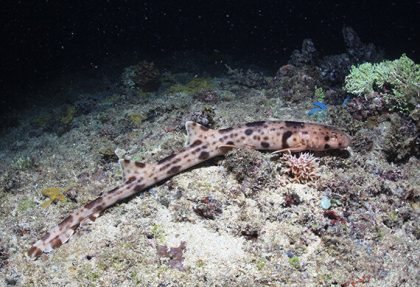Can Sharks Walk?
These sharks have been walking along the ocean seafloor for millions of years.

The natural world all around us is truly magnificent. And, just when you think you have heard it all—a new scientific discovery has you in a state of awe and wonder.
The latest fin-tastic discovery comes to us from researchers studying sharks in the waters surrounding Australia, Indonesia and Papua New Guinea.
Shannon Corrigan, an evolutionary biologist at the Florida Museum of Natural History in Gainesville, and her colleagues recently published a report in the journal Marine and Freshwater Research. Their initial research was meant to uncover exactly when a single species of walking shark evolved, but through the DNA sampling process, they were able to identify four brand new walking shark species! That means we now have nine species of walking sharks out there to know and love!
We LOVE science!
So, how exactly do walking sharks, well, walk?
Also called “epaulette sharks”—walking sharks ‘walk’ using their strong pectoral and pelvic fins, which allows them to forage for food under rocks and coral. They can even take short stints above water in the open air as they move between pools that form on reef habitats during low tide to search for prey.
Sharks are evolutionary superstars!
Sharks have been swimming in the Earth’s ocean for nearly 450 million years—this predates dinosaurs! And many species of sharks haven’t changed much for millions of years. So the discovery that sharks continue to evolve—shows that they are able to adapt and change—as their environment, climate and surroundings change.
Genetic research revealed that walking sharks are one of the newest groups of sharks. All nine species of walking sharks evolved or branched off from their nearest ancestor in the last 9 million years. But, why?
Scientists point out a few things that could help explain the relatively rapid pace of evolution in walking sharks. First, they live in warm shallow reefs, which are very dynamic places over time that have required the sharks to adapt to changes. Secondly, they don’t tend to stray far from where they were born, which creates separates populations and means more opportunities for them to diverge.
During mass extinction events, carpet sharks, the group that includes walking sharks, were among the “most affected” animals, researchers wrote. Sea levels rose and ocean temperatures dropped, pushing the sharks to migrate to warmer waters.
Researchers continue to study walking sharks—but very little is known about them—how overfishing, climate change and pollution are impacting their habitat and survival.
The discovery of four new species of walking sharks is one of the many reasons that we should continue working together to protect their ocean world. Who knows what new species will be discovered next? We won’t find out if we don’t protect the ocean and the animals that call it home.